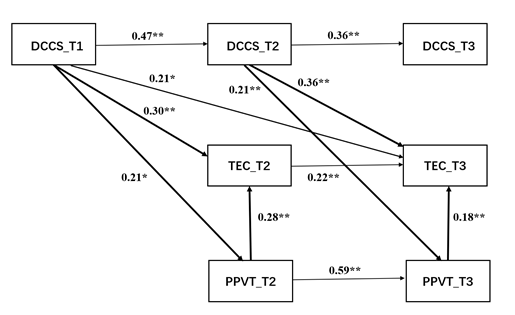情绪理解是指个体能够理解情绪产生的原因和结果,以及应用这些信息对自我和他人产生合适情绪反应的能力(Aznar & Tenenbaum, 2013; Denham et al., 2002)。作为一种重要的社会认知技能,情绪理解能力在儿童同伴交往、社会适应以及个体发展等方面均起到重要影响(Imuta et al., 2016; Longobardi, Spataro, & Rossi-Arnaud, 2015)。3-6岁是儿童情绪理解发展的关键期,因此,探究认知灵活性对幼儿情绪理解的影响对于揭示情绪理解发展的认知机制,以及指导如何提高儿童情绪能力具有重要的科学价值和实践意义。
近日,西南大学冯廷勇教授团队在著名发展心理学杂志《Journal of Experimental Child Psychology》上发表了题为“The continuous impact of cognitive flexibility on the development of emotion understanding in children aged 4 and 5 years: A longitudinal study”的研究文章。研究表明,认知灵活性对4-5岁儿童情绪理解的发展具有预测作用,并且早期认知灵活性通过提高儿童的言语能力进而促进了后期情绪理解的发展。
本研究为纵向追踪研究(The longitudinal tracking study),对98名4-5岁儿童在一年半内进行了三次认知灵活性(Dimensional Change Card Sorting, DCCS)、情绪理解(Test of Emotion Comprehension, TEC)和言语能力(The Peabody Picture Vocabulary Test, PPVT)的相关测试。为了探究认知灵活性对情绪理解发展的持续影响及其加工机制,本研究构建了交叉滞后结构方程模型(The Cross-lagged Structural Equation Modeling)和中介结构方程模型(The Mediation Structural Equation Modeling)。
交叉滞后分析表明,认知灵活性对情绪理解的发展具有预测作用,具体来说,T1的认知灵活性能够预测T2和T3的情绪理解,T2的认知灵活性能够预测T3的情绪理解。研究还发现早期认知灵活性(DCCS_T1)随着时间的变化一直影响儿童情绪理解的发展 (path coefficients in the range from 0.23 to 0.35),并且这种影响是重要和持续的(如图1所示)。

图1. 路径系数标准化后的交叉滞后结构方程模型(The cross-lagged SEM)(控制年龄后),模型拟合良好,所有路径系数均显著. *p< .05. ** p< .01.
此外,探索性中介分析发现,言语能力在认知灵活性和情绪理解之间起到中介作用,早期认知灵活性通过提高下一个时间点的言语能力进而影响儿童下一个时间点情感理解的发展(如图2所示)。

图2. 路径系数标准化后的中介结构方程模型(The mediation SEM)(控制年龄后):言语能力在认知灵活性和情绪理解之间起中介作用;PPVT_T2的中介效用为0.25,95%置信区间[0.02, 0.12], PPVT_T3的中介效用为0.31,95%置信区间[0.01, 0.10]; 模型拟合良好,所有路径系数均显著. *p< .05. ** p< .01.
该研究采用纵向追踪研究设计,从发展的视角探讨了认知灵活性对4-5岁儿童情绪理解的持续影响,并发现认知灵活性与情绪理解之间存在一条以言语能力为中介的发展途径,这对于进一步了解儿童情绪理解发展的认知加工机制具有重要的科学价值,也为提升和干预儿童情绪理解能力提供了新的视角。该论文的第一作者为研究生王雪珂,通讯作者为冯廷勇教授,该研究受到国家自然科学基金项目(31971026, SWU2009104)资助。
文章索引
Wang X., Chen l., & Feng T., (2020). The continuous impact of cognitive flexibility on the development of emotion understanding in children aged 4 and 5 years: A longitudinal study. Journal of Experimental Child Psychology. 2021. https://doi.org/10.1016/j.jecp.2020.105018
原文摘要
The current study investigated the impact of cognitive flexibility on the development of emotion understanding using a longitudinal tracking study. A total of 98 children aged 4 and 5 years were tested for cognitive flexibility, emotion understanding, and verbal ability across three time points within a year. The cross-lagged analyses indicated that early cognitive flexibility played a predictive role in the development of emotion understanding. More precisely, cognitive flexibility at Time 1 predicted emotion understanding at Time 2 and Time 3, and cognitive flexibility at Time 2 predicted emotion understanding at Time 3. Furthermore, mediation analysis showed that verbal ability mediated the impact of cognitive flexibility on emotion understanding. Early cognitive flexibility contributed to later emotion understanding by improving children s verbal ability. These findings suggest that there is a verbal ability-mediated pathway from cognitive flexibility to emotion understanding that provides a new perspective for the development mechanism of children s emotion understanding.





